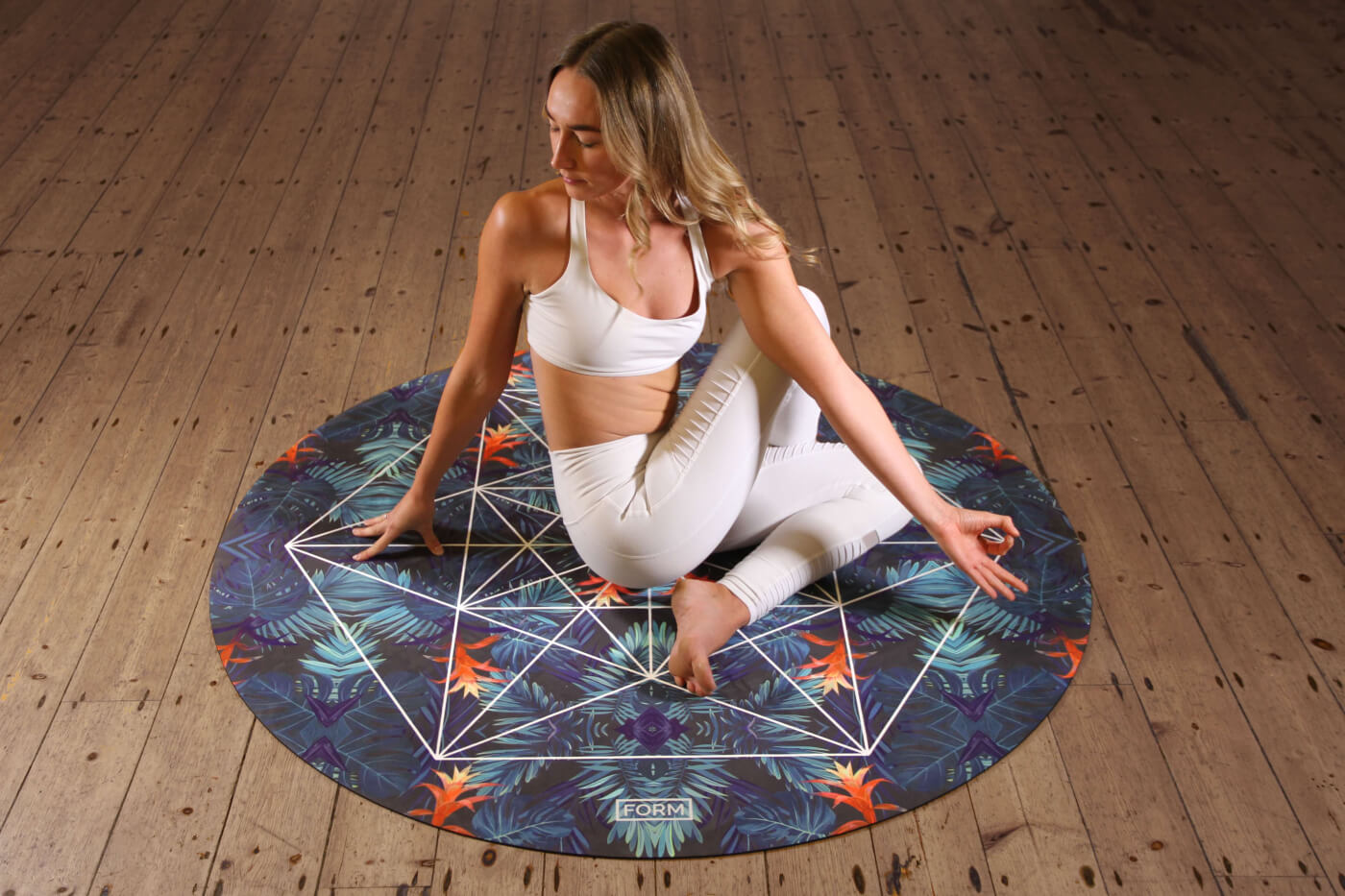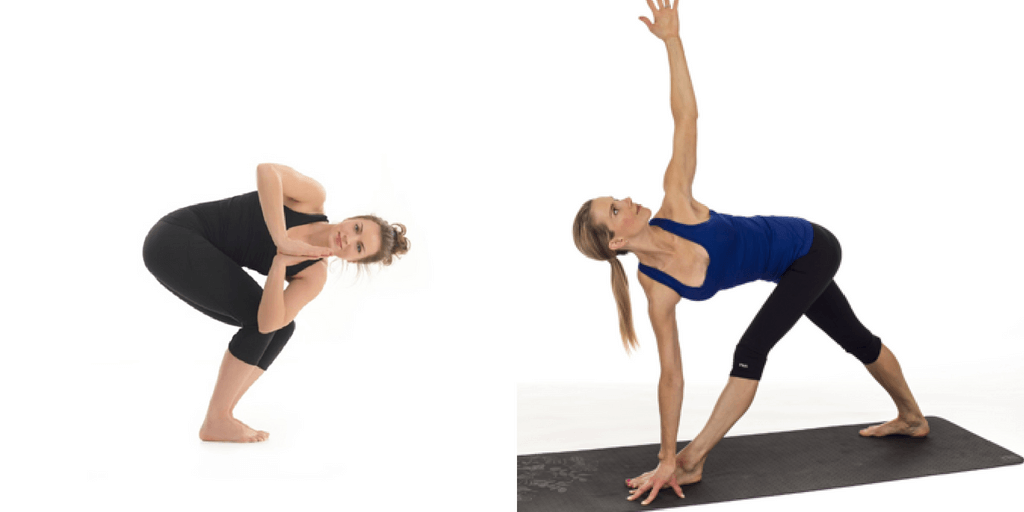Get Hip on Twists…Stop Being So Square!

In this post find out why being square may not be so hip when it comes to twists. If you want the quick and easy version, scroll down to the end to watch a video for a better understanding of where the SI joint is and what it means to let the pelvis rotate.
While there are many elements important to think about when twisting, in this blog I want to talk about the hips. To square or not to square? That is the question. I will introduce you to three expert opinions that may have you rethinking what you have been doing in a twist.
Why is it a Good Idea to Revisit Body Anatomy? Or for Some to Take a Closer Look for the First Time?
I get it…if you’re a teacher you may thinking “I did my yoga teacher training and learned this already.” The truth is Yoga Alliance Teacher Training Programs only require 10 hours of hands-on anatomy training. Because of this, the focus is on understanding basic anatomy: bones, ligaments, planes of movement and a little more if time allows.
And when teaching yoga poses, we were likely taught a “right way” to do a pose that is safe and a “wrong way” that is not safe. You most likely left your training with basic knowledge and a black and white view of how to teach what we assume will keep our students safe.
The tendency is to stick to this year over year because this is what we learned (and let’s be honest, none of us really want to open another yoga anatomy text book). And if you’re a student, you may not question when your teacher tells you to square your hips…and maybe you should.
I’ll bet some of you know more about how your computer or smart phone work than your body.
I know…the body can be complicated, but my blog and web site are designed to make it easier to understand so that your yoga practice can last you for the long haul.
In what follows, I want to propose that this “one size fits all” approach is a thing of the past and the future consists of giving our students options that FEEL good in their bodies.
There will always be certain alignment cues we need to be sticklers on when it comes to safety, but I am suggesting it is time to embrace the gray space around how to “correctly” do poses given that every BODY is different.
I have done the reading and researching for you and will concisely provide what I have found to be the most potent and relevant pieces of expert knowledge (when I say experts, I am referring to long time instructors who either have a background in anatomy/biomechanics or have studied extensively with those that do; as well as doctors, Physical Therapists and Chiropractors who teach yoga).
So, sit back, relax and let’s dig deeper into the anatomy of twists.
So, is Really Safer to Square the Hips in a Twist?
You will be surprised to hear what some experts agree the answer is to this question: NOT NECESSARILY. Initiating the twist from the pelvis and allowing the hips to become uneven may feel better and be safer for certain students. And some yoga instructors and body experts feel rotating the pelvis first in a twist is the way it should be taught for most students.
I know, you’re thinking “WHAT?” It’s okay…take a few ujjayi breaths and keep reading.
Our first expert is Jason Crandell (considered a “teacher’s teacher”, leads global trainings, and a contributing editor to Yoga Journal).
He believes that the spine and pelvis work best when moving together. Turning the pelvis while twisting allows your ilium to move with your sacrum so that the two bones stay together, rather than separating. Crandell elaborates on this concept by explaining that the spine and the pelvis are structurally fused at the sacrum and coccyx – not to mention all the ligaments, tendons and other soft tissues that bind the spine and pelvis together. Therefore, moving the spine and pelvis together creates a cohesive motion that minimizes concentrated pressure in the low back and SI joints.
My two cents: The BIG takeaway for me in Jason’s post comes from looking at the pictures. If you haven’t yet, take a look! In revolved utkatasana, revolved triangle and more, the hips are not level. Yikes!
In poses where the legs are not side by side, I will look to see if their back leg is collapsing or not engaged and I will have them root through their back foot and lift through their inner leg line just to keep the leg strong.
In poses where there is symmetry in the hips, like revolved utkatasana and revolved paddottanasana, I will cue to root through the feet and feel the power and strength coming from their legs. This way, again, I believe it helps to keep them from hanging in the joints.

The next expert is Roger Cole (PhD, certified Iyengar teacher).
He says there’s no one right technique for everyone but a good rule is that if you don’t twist easily or if you already have pain in your SI region, you are probably better off turning your pelvis and hips as you twist. If you twist easily and want to go deeper, a squared pelvis may be the way to go.
My two cents: If you know you are already quite flexible (I’m talking to you yoga teachers and long time students), what’s the purpose of wanting to twist deeper in a pose? There is plenty of research saying that our spines are meant for stability and too much range of motion can be problematic.
I am not saying everyone will have issues if they become too flexible, but I am asking you to ask yourself what the purpose is if you are looking for that. Having mobility in the spine is important but how much is too much?
Taking the Pressure Off the SI Joints

Cole suggests that beginning a twist by rotating your pelvis allows your torso to turn farther, making the pose feel complete sooner. Therefore, you are not as likely to “overdo” it. Also, in deep twists where you bring your arm outside your leg, turning your pelvis makes it easier to get into that position so you are less likely to slump/round in your spine.
Cole says to relax the muscles around the spine, waist and rib cage so your spine can turn more freely and won’t send as much force down to the sacrum.
My two cents: In group classes, I usually cue to let the twist be gentle so that students are less likely to muscle their way through it and go too far. There is a difference between “hanging out” in your joints and controlling the movement. If you are allowing the pelvis to rotate, keep your legs strong and control the twist. I don’t get worked up when I see slight rounding in the back while twisting but when it’s excessive (usually in the tighter folks), I will have them use blocks or bend their knees to help them lengthen the spine.
Our last expert for today’s post is Robyn Capobianco (PhD, Neurophysiology of Movement and Research Scientist).
She offers even more SI stabilization advice in yoga twisting with the concept of “forced closure” (to hear about forced closure in twist go to 23 minutes in) This technique can help keep the SI joints more stable (yes the consensus is the SI joints can move) by engaging the lat (latissimus dorsi) and opposite side gluteal muscle.
For example, in revolved triangle to the right, you would draw the left side lat down and engage the right glute.
Robyn also says as we age, especially women, naturally we develop some degeneration in our spines and, therefore, are more susceptible to back issues. She also pointed out that she saw (not sure exactly how) the uncoupling of the joint when practicing revolved triangle too deeply and as instructors we need to be careful when adjusting students in twist not take it too far.
My two cents: It’s important that we be open to realizing what we were taught from generations of yogis passed down may be more aggravating for some of us than others. THERE IS NOT ONE RIGHT WAY. While many believe that there is slight movement in the SI joint, which is natural, too much movement can be problematic. The cue of engaging the opposite lat and glute in twisting poses has given quite a few of my students more support in the twist.
If you have read something about the SI joint not being able to be overstretched, be open to realizing that for some that may not be the case. There are plenty of well respected Dr’s, PT’s and body workers who believe it absolutely can be…especially in women who have had children. And then there are well respected experts that believe it can’t. Read and listen to both sides. What feels best for you?
Applying the Idea of Twisting Without Keeping the Hips Square
I’ll end this post with a video by Jason Brown (founder of Functional Anatomy Academy, seasoned yoga teacher, clinical massage therapist, and functional anatomy educator) demonstrating the benefits of letting the pelvis rotate in revolved triangle. You will see how this approach has three distinct benefits for this particular pose:
- Reduces the amount of pressure at the SI joints and low back
- Enables stretching of the hip abductors, lateral rotators, lateral hamstrings and IT band
- Releases tension in the neck and top shoulder
Until recently we didn’t have access to some of the science and information around the yoga poses that we do now. While our bodies will speak to us (pain and pleasure), we can learn a lot from these experts and body workers who are taking this ancient practice and adding 21st century knowledge. So, let’s be open to exploring and keeping our minds as open as we’d like to keep our bodies!
